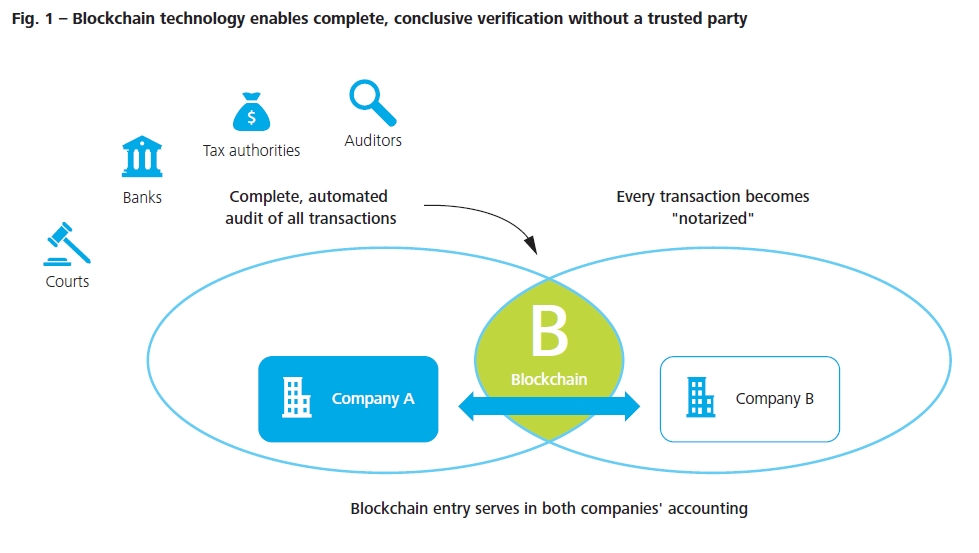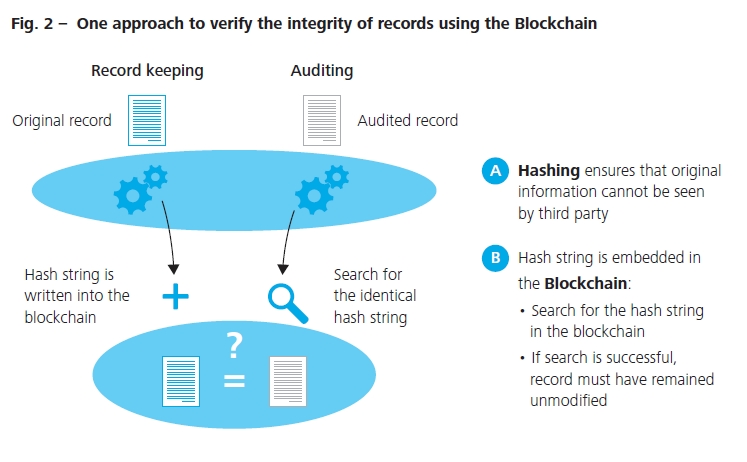Current state of accounting technology
Digitalisation of the accounting system is still in its infancy compared to other industries, some of which have been massively disrupted by the advances of technology. Some of the reasons may be found in the exceptionally high regulatory requirements in respect to validity and integrity. The entire accounting system is built, such that forgery is impossible or at least very costly. To achieve this it relies on mutual control mechanisms, checks and balances. This inevitably affects every day’s operations. Among other things there are systematic duplication of efforts, extensive documentations and periodical controls. Most of them are manual, labour intensive tasks and far from being automated. To date, that seemed to be the sacrifice of revealing the truth.
The recently emerged Blockchain is a trustless, distributed ledger that is openly available and has negligible costs of use. The use of the Blockchain for accounting use-cases is hugely promising. From simplifying the compliance with regulatory requirements to enhancing the prevalent double entry bookkeeping, anything is imaginable.
The giant leap: How the Blockchain may enhance today’s accounting practice
Modern financial accounting is based on a double entry system. Double entry bookkeeping revolutionized the field of financial accounting during the Renaissance period; it solved the problem of managers knowing whether they could trust their own books. However, to gain the trust of outsiders, independent public auditors also verify the company’s financial information (1). Each audit is a costly exercise, binding the company’s accountants for long time periods.
Digitalisation of the accounting system is still in its infancy compared to other industries, some of which have been massively disrupted by the advances of technology. Some of the reasons may be found in the exceptionally high regulatory requirements in respect to validity and integrity. The entire accounting system is built, such that forgery is impossible or at least very costly. To achieve this it relies on mutual control mechanisms, checks and balances. This inevitably affects every day’s operations. Among other things there are systematic duplication of efforts, extensive documentations and periodical controls. Most of them are manual, labour intensive tasks and far from being automated. To date, that seemed to be the sacrifice of revealing the truth.
The recently emerged Blockchain is a trustless, distributed ledger that is openly available and has negligible costs of use. The use of the Blockchain for accounting use-cases is hugely promising. From simplifying the compliance with regulatory requirements to enhancing the prevalent double entry bookkeeping, anything is imaginable.
The giant leap: How the Blockchain may enhance today’s accounting practice
Modern financial accounting is based on a double entry system. Double entry bookkeeping revolutionized the field of financial accounting during the Renaissance period; it solved the problem of managers knowing whether they could trust their own books. However, to gain the trust of outsiders, independent public auditors also verify the company’s financial information (1). Each audit is a costly exercise, binding the company’s accountants for long time periods.
Blockchain technology may represent the next step for accounting: (2) Instead of keeping separate records based on transaction receipts, companies can write their transactions directly into a joint register, creating an interlocking system of enduring accounting records. Since all entries are distributed and cryptographically sealed, falsifying or destroying them to conceal activity is practically impossible. It is similar to the transaction being verified by a notary – only in an electronic way.
The companies would benefit in many ways: Standardisation would allow auditors to verify a large portion of the most important data behind the financial statements automatically. The cost and time necessary to conduct an audit would decline considerably. Auditors could spend freed up time on areas they can add more value, e.g. on very complex transactions or on internal control mechanisms.
First steps towards Blockchain based accounting
It is not necessary to start with a joint register for all accounting-entries. The Blockchain as a source of trust can also be extremely helpful in today’s accounting structures. It can be gradually integrated with typical accounting procedures: starting from securing the integrity of records, to completely traceable audit trails. At the end of the road, fully automated audits may be reality.
At first, let us have a look at the case of keeping immutable records. The regulatory requirements for record keeping in Germany for example urge the proof of immutability over the entire retention period. For paper receipts, the risk of unnoticed modification is seen as comparably low, because of their physical nature. In contrast, electronic files cannot be perceived physically and hence are especially vulnerable. As a consequence, digitalizing paper records introduces the necessity for further preventive measures.
The result is a wide range of organizatory, technological and processual provisions. All preventive measures have to be documented in a conclusive manner for third parties. Unsurprisingly, many companies shy away from introducing a holistic electronic archiving system, although they are aware of the benefits.
Using the Blockchain makes it possible to prove integrity of electronic files easily. One approach is to generate a hash string of the file. That hash string represents the digital fingerprint of that file. Next, that fingerprint is immutably timestamped by writing it into the Blockchain via a transaction.
At any subsequent point in time, one can prove the integrity of that file by again generating the fingerprint and comparing it with the fingerprint stored in the Blockchain. In case the fingerprints are identical, the document remained unaltered since first writing the hash to the Blockchain.
The companies would benefit in many ways: Standardisation would allow auditors to verify a large portion of the most important data behind the financial statements automatically. The cost and time necessary to conduct an audit would decline considerably. Auditors could spend freed up time on areas they can add more value, e.g. on very complex transactions or on internal control mechanisms.
First steps towards Blockchain based accounting
It is not necessary to start with a joint register for all accounting-entries. The Blockchain as a source of trust can also be extremely helpful in today’s accounting structures. It can be gradually integrated with typical accounting procedures: starting from securing the integrity of records, to completely traceable audit trails. At the end of the road, fully automated audits may be reality.
At first, let us have a look at the case of keeping immutable records. The regulatory requirements for record keeping in Germany for example urge the proof of immutability over the entire retention period. For paper receipts, the risk of unnoticed modification is seen as comparably low, because of their physical nature. In contrast, electronic files cannot be perceived physically and hence are especially vulnerable. As a consequence, digitalizing paper records introduces the necessity for further preventive measures.
The result is a wide range of organizatory, technological and processual provisions. All preventive measures have to be documented in a conclusive manner for third parties. Unsurprisingly, many companies shy away from introducing a holistic electronic archiving system, although they are aware of the benefits.
Using the Blockchain makes it possible to prove integrity of electronic files easily. One approach is to generate a hash string of the file. That hash string represents the digital fingerprint of that file. Next, that fingerprint is immutably timestamped by writing it into the Blockchain via a transaction.
At any subsequent point in time, one can prove the integrity of that file by again generating the fingerprint and comparing it with the fingerprint stored in the Blockchain. In case the fingerprints are identical, the document remained unaltered since first writing the hash to the Blockchain.
Timestamping can be conducted at any point of the documents life cycle and render any subsequent organizatory, technological and processual integrity provision obsolete. Preferably, the fingerprint should be timestamped right after the creation of the electronic document, even before the document is sent from the issuer to the recipient. That way one can rule out the risk of the document being modified over the entire document life-cycle. For archiving the document, usual data storages may be used, because the integrity can be proven easily.
To extend this concept, one may represent the life-cycle of each accounting incident on the Blockchain, including all relevant documents. Entire business processes, spanning over multiple departments or companies become easily traceable.
Finally, blockchain technology allows for smart contracts, i.e. computer programs that may execute under certain conditions. Think of an invoice paying for itself after checking that delivered goods have been received according to specifications and sufficient funds are available on the company’s bank account.
Conclusion
The blockchain technology has the potential to shapeshift the nature of today’s accounting. It may constitute a way to vastly automate accounting processes in compliance with the regulatory requirements. As described above, there are numerous starting points to leverage blockchain technology. A cascade of new applications will likely follow that are built on top of each other, leading way for new, unprecedented services.
(1) Stakeholders place their trust in the auditors retained by management to vouch for them. An obvious problem of agency is created by this arrangement: Do auditors work for the managers who hire and pay them or for the public that relies on their integrity in order to make decisions?
(2) For a more detailed explanation of the concepts also known as “triple entry accounting”, also refer to Ian Grigg’s paper “Triple Entry Accounting” or Bitcoin Magazine’s article authored by Jason M. Tyra.
By Nicolai Andersen
Partner, Leader Innovation
Deloitte Deutschland
www.deloitte.de
For more information please visit our website www.deloitte.com/de/blockchain
To extend this concept, one may represent the life-cycle of each accounting incident on the Blockchain, including all relevant documents. Entire business processes, spanning over multiple departments or companies become easily traceable.
Finally, blockchain technology allows for smart contracts, i.e. computer programs that may execute under certain conditions. Think of an invoice paying for itself after checking that delivered goods have been received according to specifications and sufficient funds are available on the company’s bank account.
Conclusion
The blockchain technology has the potential to shapeshift the nature of today’s accounting. It may constitute a way to vastly automate accounting processes in compliance with the regulatory requirements. As described above, there are numerous starting points to leverage blockchain technology. A cascade of new applications will likely follow that are built on top of each other, leading way for new, unprecedented services.
(1) Stakeholders place their trust in the auditors retained by management to vouch for them. An obvious problem of agency is created by this arrangement: Do auditors work for the managers who hire and pay them or for the public that relies on their integrity in order to make decisions?
(2) For a more detailed explanation of the concepts also known as “triple entry accounting”, also refer to Ian Grigg’s paper “Triple Entry Accounting” or Bitcoin Magazine’s article authored by Jason M. Tyra.
By Nicolai Andersen
Partner, Leader Innovation
Deloitte Deutschland
www.deloitte.de
For more information please visit our website www.deloitte.com/de/blockchain
Pour lire tous les articles Finyear dédiés Blockchain rendez-vous sur www.finyear.com/search/Blockchain/
Participez aux conférences Blockchain éditées par Finyear :
Assurchain (6 avril 2016)
Blockchain Vision ( 12 avril 2016)
Blockchain Pitch Day (10 mai 2016)
Blockchain, IoT & IA (projet juin 2016)
Blockchain Hackathon (projet septembre 2016)
Participez aux conférences Blockchain éditées par Finyear :
Assurchain (6 avril 2016)
Blockchain Vision ( 12 avril 2016)
Blockchain Pitch Day (10 mai 2016)
Blockchain, IoT & IA (projet juin 2016)
Blockchain Hackathon (projet septembre 2016)
Les médias du groupe Finyear
Lisez gratuitement :
Le quotidien Finyear :
- Finyear Quotidien
La newsletter quotidienne :
- Finyear Newsletter
Recevez chaque matin par mail la newsletter Finyear, une sélection quotidienne des meilleures infos et expertises de la finance d’entreprise et de la finance d'affaires.
Les 6 lettres mensuelles digitales :
- Le Directeur Financier
- Le Trésorier
- Le Credit Manager
- The FinTecher
- The Blockchainer
- Le Capital Investisseur
Le magazine trimestriel digital :
- Finyear Magazine
Un seul formulaire d'abonnement pour recevoir un avis de publication pour une ou plusieurs lettres
Le quotidien Finyear :
- Finyear Quotidien
La newsletter quotidienne :
- Finyear Newsletter
Recevez chaque matin par mail la newsletter Finyear, une sélection quotidienne des meilleures infos et expertises de la finance d’entreprise et de la finance d'affaires.
Les 6 lettres mensuelles digitales :
- Le Directeur Financier
- Le Trésorier
- Le Credit Manager
- The FinTecher
- The Blockchainer
- Le Capital Investisseur
Le magazine trimestriel digital :
- Finyear Magazine
Un seul formulaire d'abonnement pour recevoir un avis de publication pour une ou plusieurs lettres
Autres articles
-
Pomelo annonce une Série A à 35 millions de dollars menée par Vy Capital
-
Shiba Inu lève 12 millions de dollars pour lancer sa propre Blockchain
-
Louis Vuitton dévoile un nouveau Collectible exclusif pour sa Communauté VIA
-
Nomination | Paymium confie sa stratégie à Alexandre Stachtchenko
-
"La dernière fraction de Bitcoin devrait être émise aux alentours de 2140", Claire Balva, VP Stratégie Deblock




















